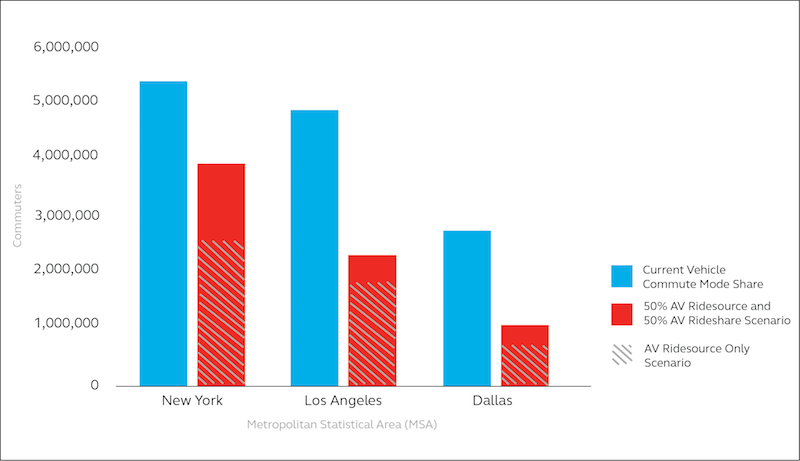A study by transportation, economics and urban planning experts has found that ridesharing and ridesourcing services using autonomous vehicles (AV) could shift millions of drivers away from personal cars in major U.S. cities.
“Driverless Future: A Policy Roadmap for City Leaders,” the study prepared by Arcadis, HR&A Advisors and Sam Schwartz Consulting, shows that the move to ridesharing and ridesourcing services that don’t have a driver could cause a shift of up to 60 percent (3.6 million cars) from traditional to autonomous vehicles in the New York metro area alone over the next 15-20 years.
The Los Angeles metro area could see a shift of up to 44 percent (2.2 million cars) and the Dallas-Ft. Worth metro area could see a shift of up to 31 percent (nearly 1 million cars).
The shift of nearly 7 million drivers to autonomous vehicles across three diverse metro areas illustrates how cities across the U.S. could be greatly impacted and reveals the significant effect of driverless services contemplated by companies such as Uber and Lyft.
To help cities prepare for such profound changes in daily life, Arcadis, HR&A Advisors and Sam Schwartz Consulting are offering a policy road map for complex issues related to autonomous vehicles and their potential impact on equity, public transit, parking, land use, and real estate development.
To prepare for this driverless future, the report identifies six priorities for city leaders:
- Leverage technology to enhance mobility: Cities and private partners should embrace smartcards, open data, and universal apps. This would allow riders to compare, book, and pay for trips that combine buses, trains, bikes and ridesharing. Pilot programs are already in place in cities ranging from Los Angeles to Helsinki.
- Prioritize and modernize public transit: Cities and transit agencies should focus on high-ridership, high-frequency light rail and bus rapid transit systems while driverless shuttles provide first- and last-mile connections for riders. Similar shuttles are already being tested in London and Singapore.
- Implement dynamic pricing: To reduce congestion and create a level playing field between public and private transportation, cities should consider dynamic road pricing plans that vary by origin and destination, number of passengers, congestion, and/or household income. This can be implemented through proven tools such as congestion pricing, zone pricing, vehicle-miles traveled fee, etc.
- Plan for mixed-use, car-light neighborhoods: AV can unlock demand for living and working in mixed-use neighborhoods – whether they are urban or suburban. To shape this demand, cities need to plan for and incentivize mixed-use development, overhaul parking requirements, and reevaluate new transit projects.
- Encourage adaptable parking: Fewer personal cars means fewer parking spaces, especially in city centers where much of the land use is taken by parking garages or lots. Parking garages need to be built with housing or office conversion in mind and include level floors, higher ceiling heights and centralized ramps. These future-proof garages are already being contemplated in Boston and Nashville.
- Promote equitable access to new jobs and services: To support disadvantaged populations, cities must encourage public and private operators to provide alternative payment methods, access via dial-a-ride and equitable service coverage. Cities and private partners must also create new employment and training opportunities for drivers and others in legacy occupations.
The full report can be found here.
Related Stories
MFPRO+ Research | Feb 28, 2024
New download: BD+C's 2023 Multifamily Amenities report
New research from Building Design+Construction and Multifamily Pro+ highlights the 127 top amenities that developers, property owners, architects, contractors, and builders are providing in today’s apartment, condominium, student housing, and senior living communities.
MFPRO+ Research | Feb 27, 2024
Most competitive rental markets of early 2024
The U.S. rental market in early 2024 is moderately competitive, with apartments taking an average of 41 days to find tenants, according to the latest RentCafe Market Competitivity Report.
Student Housing | Feb 21, 2024
Student housing preleasing continues to grow at record pace
Student housing preleasing continues to be robust even as rent growth has decelerated, according to the latest Yardi Matrix National Student Housing Report.
Multifamily Housing | Feb 14, 2024
Multifamily rent remains flat at $1,710 in January
The multifamily market was stable at the start of 2024, despite the pressure of a supply boom in some markets, according to the latest Yardi Matrix National Multifamily Report.
Industry Research | Feb 8, 2024
New multifamily development in 2023 exceeded expectations
Despite a problematic financing environment, 2023 multifamily construction starts held up “remarkably well” according to the latest Yardi Matrix report.
Industry Research | Jan 31, 2024
ASID identifies 11 design trends coming in 2024
The Trends Outlook Report by the American Society of Interior Designers (ASID) is the first of a three-part outlook series on interior design. This design trends report demonstrates the importance of connection and authenticity.
Apartments | Jan 26, 2024
New apartment supply: Top 5 metros delivering in 2024
Nationally, the total new apartment supply amounts to around 1.4 million units—well exceeding the apartment development historical average of 980,000 units.
Self-Storage Facilities | Jan 25, 2024
One-quarter of self-storage renters are Millennials
Interest in self-storage has increased in over 75% of the top metros according to the latest StorageCafe survey of self-storage preferences. Today, Millennials make up 25% of all self-storage renters.
Industry Research | Jan 23, 2024
Leading economists forecast 4% growth in construction spending for nonresidential buildings in 2024
Spending on nonresidential buildings will see a modest 4% increase in 2024, after increasing by more than 20% last year according to The American Institute of Architects’ latest Consensus Construction Forecast. The pace will slow to just over 1% growth in 2025, a marked difference from the strong performance in 2023.
Adaptive Reuse | Jan 23, 2024
Adaptive reuse report shows 55K impact of office-to-residential conversions
The latest RentCafe annual Adaptive Reuse report shows that there are 55,300 office-to-residential units in the pipeline as of 2024—four times as much compared to 2021.

















